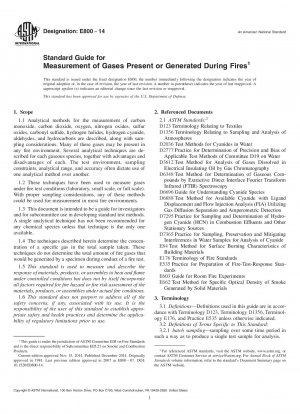ASTM E800-14
Standard Guide for Measurement of Gases Present or Generated During Fires
- Standard No.
- ASTM E800-14
- Release Date
- 2014
- Published By
- American Society for Testing and Materials (ASTM)
- Status
- Replace By
- ASTM E800-20
- Latest
- ASTM E800-20
- Scope
4.1 Because of the loss of life in fires from inhalation of fire gases, much attention has been focused on the analyses of these species. Analysis has involved several new or modified methods, since common analytical techniques have often proven to be inappropriate for the combinations of various gases and low concentrations existing in fire gas mixtures.
4.2 In the measurement of fire gases, it is imperative to use procedures that are both reliable and appropriate to the unique atmosphere of a given fire environment. To maximize the reliability of test results, it is essential to establish the following:
4.2.1 That gaseous samples are representative of the compositions existing at the point of sampling,
4.2.2 That transfer and pretreatment of samples occur without loss, or with known efficiency, and
4.2.3 That data provided by the analytical instruments are accurate for the compositions and concentrations at the point of sampling.
4.3 This document includes a comprehensive survey that will permit an individual, technically skilled and practiced in the study of analytical chemistry, to select a suitable technique from among the alternatives. It will not provide enough information for the setup and use of a procedure (this information is available in the references).
4.4 Data generated by the use of techniques cited in this document should not be used to rank materials for regulatory purposes.
1.1 Analytical methods for the measurement of carbon monoxide, carbon dioxide, oxygen, nitrogen oxides, sulfur oxides, carbonyl sulfide, hydrogen halides, hydrogen cyanide, aldehydes, and hydrocarbons are described, along with sampling considerations. Many of these gases may be present in any fire environment. Several analytical techniques are described for each gaseous species, together with advantages and disadvantages of each. The test environment, sampling constraints, analytical range, and accuracy often dictate use of one analytical method over another.
1.2 These techniques have been used to measure gases under fire test conditions (laboratory, small scale, or full scale). With proper sampling considerations, any of these methods could be used for measurement in most fire environments.
1.3 This document is intended to be a guide for investigators and for subcommittee use in developing standard test methods. A single analytical technique has not been recommended for any chemical species unless that technique is the only one available.
1.4 The techniques described herein determine the concentration of a specific gas in the total sample taken. These techniques do not determine the total amount of fire gases that would be generated by a specimen during conduct of a fire test.
1.5 This standard is used to me......
ASTM E800-14 Referenced Document
- ASTM D123 Standard Terminology Relating to Textiles
- ASTM D1356 Standard Terminology Relating to Sampling and Analysis of Atmospheres*, 2024-04-20 Update
- ASTM D2036 Standard Test Methods for Cyanides in Water
- ASTM D2777 Standard Practice for Determination of Precision and Bias of Applicable Methods of Committee D-19 on Water
- ASTM D3612 Standard Test Method for Analysis of Gases Dissolved in Electrical Insulating Oil by Gas Chromatography
- ASTM D6348 Standard Test Method for Determination of Gaseous Compounds by Extractive Direct Interface Fourier Transform Infrared (FTIR) Spectroscopy
- ASTM D6696 Standard Guide for Understanding Cyanide Species
- ASTM D6888 Standard Test Method for Available Cyanides with Ligand Displacement and Flow Injection Analysis (FIA) Utilizing Gas Diffusion Separation and Amperometric Detection
- ASTM D7295 Standard Practice for Sampling Combustion Effluents and Other Stationary Sources for the Subsequent Determination of Hydrogen Cyanide
- ASTM D7365 Standard Practice for Sampling, Preservation and Mitigating Interferences in Water Samples for Analysis of Cyanide
- ASTM E176 Standard Terminology of Fire Standards
- ASTM E535 Standard Practice for Preparation of Fire-Test-Response Standards
- ASTM E603 Standard Guide for Room Fire Experiments
- ASTM E662 Standard Test Method for Specific Optical Density of Smoke Generated by Solid Materials
- ASTM E84 Standard Test Method for Surface Burning Characteristics of Building Materials
ASTM E800-14 history
- 2020 ASTM E800-20 Standard Guide for Measurement of Gases Present or Generated During Fires
- 2014 ASTM E800-14 Standard Guide for Measurement of Gases Present or Generated During Fires
- 2007 ASTM E800-07 Standard Guide for Measurement of Gases Present or Generated During Fires
- 2006 ASTM E800-06 Standard Guide for Measurement of Gases Present or Generated During Fires
- 2005 ASTM E800-05 Standard Guide for Measurement of Gases Present or Generated During Fires
- 2001 ASTM E800-01 Standard Guide for Measurement of Gases Present or Generated During Fires
- 1999 ASTM E800-99 Standard Guide for Measurement of Gases Present or Generated During Fires

Copyright ©2024 All Rights Reserved